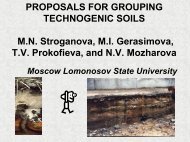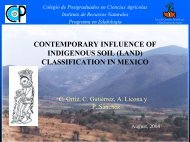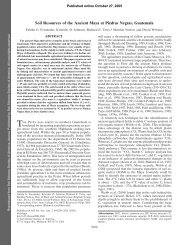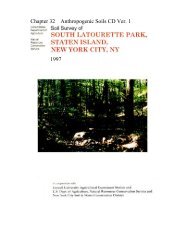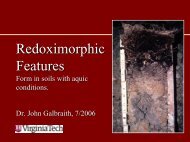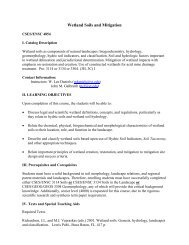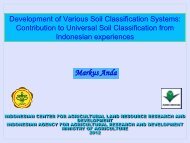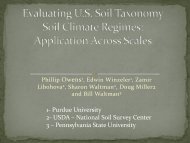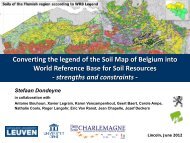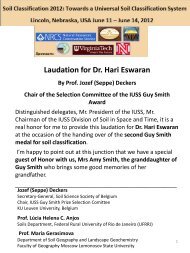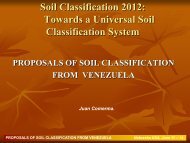Nebraska Soils Field Trip - Virginia Tech
Nebraska Soils Field Trip - Virginia Tech
Nebraska Soils Field Trip - Virginia Tech
You also want an ePaper? Increase the reach of your titles
YUMPU automatically turns print PDFs into web optimized ePapers that Google loves.
4th IUSS Soil Classification Conference <strong>Field</strong> Tour Guidebook<br />
Draft of new section on Artifacts for the National Soil Survey Handbook,<br />
Part 618--Soil Properties and Qualities<br />
(2) Significance.—Artifacts that decay quickly are similar to pararock fragments and are treated<br />
as such in sieve calculations.<br />
(3) Entries.—Enter nonpersistent or persistent in the Component Horizon Human Artifacts and<br />
Pedon Horizon Human Artifacts tables based on whether the artifact is expected to decay in<br />
less than a decade or greater than a decade. Nonpersistent artifacts are expected to decay in<br />
less than a decade. Persistent artifacts remain intact for a decade or more.<br />
I. Artifact Roundness<br />
(1) Definition.—“Artifact Roundness” is an expression of the sharpness of edges and corners of<br />
objects.<br />
(2) Significance.— The roundness of artifacts impacts water infiltration, root penetration, and<br />
macropore space.<br />
(3) Classes.—The artifact roundness classes follow those used for fragment roundness:<br />
Roundness Class Definition<br />
Very angular Strongly developed faces with very sharp, broken<br />
edges.<br />
Angular Strongly developed faces with sharp edges (Soil<br />
Survey Manual (SSM)).<br />
Subangular Detectable flat faces with slightly rounded corners.<br />
Subrounded Detectable flat faces with well-rounded corners<br />
(SSM).<br />
Rounded Flat faces absent or nearly absent with all corners<br />
rounded (SSM).<br />
Well rounded Flat faces absent with all corners rounded.<br />
(4) Entries.—Enter the appropriate artifact roundness class name for the record of artifacts<br />
populated in the Component Horizon Human Artifacts and Pedon Horizon Human Artifacts<br />
tables.<br />
J. Artifact Safety<br />
(1) Definition.—“Artifact Safety” is the degree of risk to humans from contact with soils that<br />
contain artifacts. Physical contact with soils containing dangerous or harmful artifacts should<br />
be avoided unless proper training and protective closthing is available. The risk is based on<br />
toxicity to living organisms and not the physical risk that may be present from sharp or heavy<br />
objects. Harmful toxicity may be immediate or long-term, or through direct or indirect<br />
contact. Examples of innocuous artifacts include brick, concrete, glass, plastic, unprinted<br />
paper and cardboard, and untreated wood. Some examples of noxious artifacts are batteries,<br />
bitumen (asphalt), fly ash, garbage, paper printed with metallic ink, and wood treated with<br />
arsenic.<br />
(2) Significance.—Noxious artifacts are dangerous and require special handling when sampling.<br />
Areas with noxious artifacts should have restricted human contact.<br />
140



